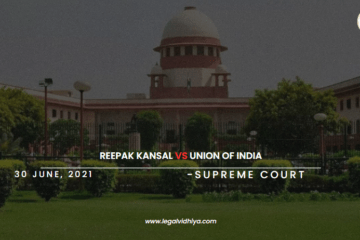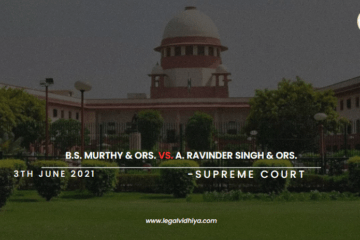![MAMTA NAIR VS. STATE OF RAJASTHAN [JULY 12, 2021]](https://legalvidhiya.com/wp-content/uploads/2024/10/Screenshot-2024-10-24-192651.png)
| CITATION | AIR 2021 SUPREME COURT 3303, AIRONLINE 2021 SC 326 |
| DATE OF JUDGMENT | July 12, 2021 |
| COURT | Supreme Court of India |
| APPELLANT | Mamta Nair |
| RESPONDENT | State of Rajasthan & Anr. |
| BENCH | Hrishikesh Roy, A.S Bopanna, N.V. Ramana |
INTRODUCTION
This case study explores a compelling court case involving an Indian spouse who was allegedly killed for honor. The victim’s wife files an appeal with the Supreme Court after being horrified by the High Court’s decision to release her brother, the main suspect. She highlights the seriousness of the charges and the possible danger to justice in her argument that the High Court’s ruling is not adequately justified. The Supreme Court’s review of the case will be broken down in detail, with an emphasis on the arguments made, the laws taken into account, and the consequences of the decision. This case highlights the intricacies of bail hearings in murder cases, especially in relation to honor killings, a pervasive social problem in India.
FACTS
The murder investigation at the center of this case is based on a 2017 First Information Report (FIR). The victim’s mother claimed that the victim’s brother-in-law (respondent No. 2) and other members of the victim’s son-in-law’s family had planned the murder as an honor killing.
The High Court initially granted bail to the respondent. The victim’s mother, however, appealed this ruling to the Supreme Court, which reversed the bail ruling on the grounds that there was “prima facie” evidence against the defendant. The respondent then submitted a fourth bail application, claiming that fresh information—such as the recording of witness statements—justified his release. The High Court granted bail without getting into the details of these testimony or how they might affect the case.
The victim’s wife’s present appeal was sparked by this ruling She draws attention to the Supreme Court’s earlier position about the presence of “prima facie” evidence and makes the case that there hasn’t been a material change in circumstances from the simple act of questioning witnesses, including herself.
ISSUES
- whether the High Court’s Decision to Grant Bail Unjustified?
- whether Evidence That Is “Prima Facie” Still Matter?
- whether It Possible to Have Fair and Efficient Justice?
APPELLANTS SIDE ARGUMENTS
The appellant, the victim’s wife, builds her case on several key arguments:
- The victim’s wife, the appellant, bases her case on a number of important points:
1. Inadequate Reasoning in the High Court’s Decision: According to the appellant, there was insufficient basis for the High Court to give the respondent bail. She argues that the High Court did not examine the witness testimonies’ content, consider how they may affect the case, or discuss the Supreme Court’s earlier rulings—rather, it only acknowledged their recording. This, she contends, falls short of the legal requirements for granting bail in a murder prosecution and shows a “mechanical” attitude to a grave subject. - 2. “Prima Facie” Findings Is Still Uncontested: The appellant highlights that the Supreme Court’s earlier ruling that the respondent is the subject of “prima facie” evidence is still a crucial element. She contends that in granted bail, the High Court did not sufficiently take this ruling into account. The appellant and other witnesses have been examined; this does not, however, negate the “prima facie” evidence that has been established, as the High Court itself recognized when it first ordered the cancellation of bail.
- Hasty to Draw a Conclusion from Partially Available Evidence: The respondent’s claim that the latest witness testimony—including her own—justifies his release is contested by the appellant. She contends that without a thorough evaluation of all the material by the trial court, it is premature and improper to make judgments based on a subset of the testimony. The appellant argues that the strength of the case against the respondent and the gravity of the accusations do not change when her testimony is considered in isolation.
- Danger to Witness Transparency and Justice: The appellant has expressed concern that the integrity of the legal system is seriously jeopardized by the respondent’s release on bail. She contends that there is a genuine risk of witness tampering, influencing the verdict of the trial, as well as the respondent fleeing given the seriousness of the accusations and the respondent’s familial links.
Essentially, the appellant is pleading with the Supreme Court to acknowledge the seriousness of the matter, maintain its earlier rulings, and make sure that justice is done. She contends that the ruling made by the High Court was incorrect and puts the pursuit of a fair and impartial trail.
RESPONDENTS SIDE ARGUMENTS
The arguments from respondent side are
• Modified Circumstances: The respondent contended that since the Supreme Court’s prior revocation of bail, the matter had advanced. They specifically noted that other witnesses, especially the applicant and the victim’s wife, were also questioned. They probably claimed that since the situation had changed, the bail should be reviewed.
• Testimony of the Appellant: It is possible that the Respondent emphasized portions of the Appellant’s testimony that they thought would support their position. In asking for bail, the respondent cited the appellant’s evidence, according to the Supreme Court’s ruling.
Why No Justification for Extended Detention: Despite the Supreme Court’s previous ruling finding “prima facie” evidence, the respondent most likely contended that later witness testimony—especially that of the appellant—weakened the prosecution’s case. They may have claimed that it was no longer appropriate to keep the detainee in custody.
JUDGEMENT
- Bail Cancellation: Concluding that the High Court’s ruling was untenable, the Supreme Court revoked the bail that had been granted to Respondent No. 2.
- Prima Facie Evidence: The Court upheld its previous position that Respondent No. 2 was the subject of “prima facie” evidence, which suggests a strong suspicion of guilt based on preliminary data.
- Inadequate Testimony of the Appellant: The Court determined that the victim’s wife could not be granted bail based just on her testimony, even though it acknowledged that she had been questioned. It made clear that the trial court’s job was to evaluate all of the available material.
- Order of Surrender: Respondent No. 2 was directed to turn himself in to the trial court.
- Rapid Trial: The trial court was instructed by the Supreme Court to resolve the case quickly, highlighting the need of a swift trial which is within one year.
ANALYSIS
- “Prima Facie” Evidence: The court upheld its previous conclusion that there was “prima facie” evidence—strong suspect of guilt established by preliminary evidence—against the accused.
- Insufficient Testimony of the Appellant: Despite the accused’s attorney highlighting the appellant’s statement at the bail hearing, the Supreme Court determined that it was not sufficient to reverse its earlier decision. The trial court bears the burden of evaluating the entirety of the evidence, the court noted.
- No Change in Circumstances: The court found that the appellant’s examination by itself did not culminate in a materially different situation that would justify granting bail once more.
- 4. Orders of the Supreme Court:
- Bail Cancelled: The accused was told to turn himself in, and the High Court’s bail decision was overturned.
CONCLUSION
In this instance, the appeal that the victim’s wife filed was accepted by the Indian Supreme Court. The decision made by the High Court to grant bail to Respondent No. 2, the accused, was found to be unsustainable and was subsequently overturned.
The Supreme Court concluded that: The victim’s wife’s inspection did not represent a material change in events sufficient for granting bail again; The High Court made a mistake in giving bail without giving proper consideration to the serious accusations, the preexisting “prima facie” evidence against the accused, and the Supreme Court’s prior position on the matter.
Consequently, the accused had been directed to turn himself in to the trial court by the Supreme Court. The trial court was instructed to wrap up the procedures within a year by the court, which emphasized the importance of a prompt trial.
REFERENCE
- SCC Online
- https://indiankanoon.org/doc/111538592/
- https://www.livelaw.in/pdf_upload/march-2022-reportable-judgments-sc-vidhi-thaker-and-prastut-dalvi-live-law-414385.pdf
This Article is written by Bandi Yogitha, student of Damodaram Sanjivayya National Law Univercity, Vishakapatnam; Intern at Legal Vidhiya.
Disclaimer: The materials provided herein are intended solely for informational purposes. Accessing or using the site or the materials does not establish an attorney-client relationship. The information presented on this site is not to be construed as legal or professional advice, and it should not be relied upon for such purposes or used as a substitute for advice from a licensed attorney in your state. Additionally, the viewpoint presented by the author is of a personal nature.

![COMMISSIONER OF INCOME TAX-I vs. M/s RELIANCE ENERGY LTD. (FORMERLY BSES LTD.) THROUGH ITS M.D. [APRIL 28, 2021].](https://legalvidhiya.com/wp-content/uploads/2024/10/Screenshot-2024-10-24-194927-360x240.png)


0 Comments